Tools are actual things--like pages of visuals + text, (display) boards, (playing) cards, or objects that teachers and learners can show, give and take, and talk or write about before, during, and/or after interactive language lessons. Techniques are steps to follow individually, co-operatively, and/or competitively: they fit together like pieces of an instructional jigsaw puzzle. Tips are suggestions for how to make optimal use of tools and techniques in various educational situations.
The following PDF'd Files--and the many, many more to be added--contain teaching and learning tools, techniques, tips, and other stimuli. These two-to ten-page sets of ideas, instructions, and classroom-ready reproducibles are all easy to view, print out, duplicate, and make optimal use of in a surprisingly creative and flexible number of ways.
To get started, simply click on a topic printed in red or the image of one of its pages.
Alphabet Activities, Five (5) Most Productive. Perhaps, the most productively
engaging and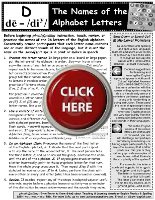 motivating generic activities to use for instruction in basic literacy are: [1] performing an oral chain, [2] playing Bingo or Lotto, [3] pairing up for Grid Games, [4] playing cards, and [5] doing puzzles. These five excerpts from Alphabet Answers: Everything to Know (Now . . .) About Teaching & Learning Alphabets [ISBN 978-1-934637-01-2] will tell you how to create, set up, and/or conduct such activities. Later on, their principles can be applied to a large variety of “more advanced” language-learning topics.
motivating generic activities to use for instruction in basic literacy are: [1] performing an oral chain, [2] playing Bingo or Lotto, [3] pairing up for Grid Games, [4] playing cards, and [5] doing puzzles. These five excerpts from Alphabet Answers: Everything to Know (Now . . .) About Teaching & Learning Alphabets [ISBN 978-1-934637-01-2] will tell you how to create, set up, and/or conduct such activities. Later on, their principles can be applied to a large variety of “more advanced” language-learning topics.
Alphabet-Letter Activity Puzzles. Even pre–or semi-literate English language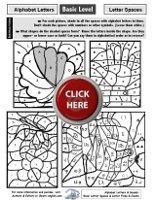
learners are likely to learn more eagerly with appropriately leveled activities that engage and challenge. After a pedagogical Intro and before a corresponding Answer Key,these four excerpts from PhonicSpelling Puzzles, Basic Level [ISBN 978-1-934637-42-5] will serve as examples of what can be accomplished
from the very start.
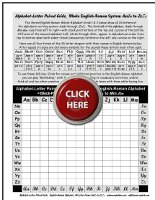
Alphabet Practice = Paired-Grid Games. Follow these instructions to make Paired-Grid pages of your own to (help your English-language learners) practice and imbed the letters of the Roman alphabet. These immediately useable pages are excerpted from Alphabet-Letter Paired-Grids Tear-Off Pad, English-Roman [ISBN 978-1-934637-32-6].
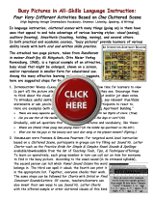
All-Skills Language Instruction = Busy Pictures. One cluttered (activity) scene with many things (going on) in it can be used for a variety of language lessons that appeal to just about all learning styles. Get step-by-step instructions for four very different kinds of activities with a 2-page printable full-color sample.
Content Teaching & Learning = Quiz-Board Knowledge. Other than “lecture,” text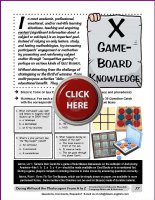
reading, and testing, there are many effective ways to present and practice the content of useful subjects of study. One of the simplest to prepare is a question-and-answer competition played on a familiar, classic game board. Idea X from the newly revised classic resource Doing Without the Photocopier [ISBN 978-0-9627878-4-3] will tell you what you need to know.
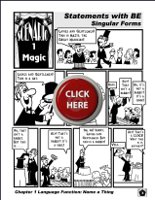
Grammar Lesson = Statements with BE. Get a full, 7-page lesson on the subject of Statements with BE that serves as a template for the best steps to follow in grammar presentation, practice, and use in context. These pages 5 to 10 are excerpted from Scenario Book One-A [ISBN 978-1-934637-35-7] Chapter 1.
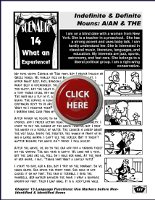 Grammar Lesson = A/AN vs. THE: This classic, everyday “disaster tale” introduces the articles a/an vs. the in context. Print itout, read it aloud, make use of its exercises and activities, and use it for instruction in personal story writing. These pages 177 to 183 are excerpted from Chapter 14 (Indefinite & Definite Nouns) of Scenario Book One-B [ISBN 978-1-891077-93-7].
Grammar Lesson = A/AN vs. THE: This classic, everyday “disaster tale” introduces the articles a/an vs. the in context. Print itout, read it aloud, make use of its exercises and activities, and use it for instruction in personal story writing. These pages 177 to 183 are excerpted from Chapter 14 (Indefinite & Definite Nouns) of Scenario Book One-B [ISBN 978-1-891077-93-7].
PhonicSpelling = Dyad Vowels & Consonants. An engaging, enjoyable way to
practice spellings for the 16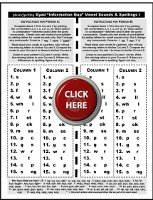 or more vowel and 24 or so consonant sounds of American English is with paired info-gap activities: these promote accurate hearing, pronunciation, and spelling of useful phonics patterns in stressed syllables. Downloading these efficiently designed pages will supply five immediately useable multi-level information-gap activities, instructions, and suggested vocabulary items. They’ll also serve as models for the creation of dyad templates targeting vocabulary of your own choosing.
or more vowel and 24 or so consonant sounds of American English is with paired info-gap activities: these promote accurate hearing, pronunciation, and spelling of useful phonics patterns in stressed syllables. Downloading these efficiently designed pages will supply five immediately useable multi-level information-gap activities, instructions, and suggested vocabulary items. They’ll also serve as models for the creation of dyad templates targeting vocabulary of your own choosing.
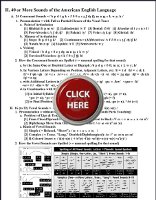
PhonicSpelling Outline = Symbols, Sounds, Word Parts + Groups: Often requested have been clear, concise but complete compilations of language-education sub-topics. The major sections of this three-page summary of info on phonics and spelling are: [I] Characters & Symbols of the American English Phonics System, [II] 40 or More Sounds of the American English Language, [III] Word Parts, and [IV] Word Pairs or Groups.
PhonicSpelling Vowel Word-Collection Grids: Many kinds of materials—especially
visuals of the kinds offered in the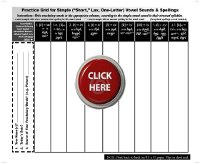 download of All-Skills Language Instruction = Busy Pictures above—lend themselves to the collection of vocabulary items categorized by their phonetic patterns. These two immediately useable, reproducible charts focus on the spellings of simple (“short,” lax) vs. complex (“long,” tense) vowel sounds.
download of All-Skills Language Instruction = Busy Pictures above—lend themselves to the collection of vocabulary items categorized by their phonetic patterns. These two immediately useable, reproducible charts focus on the spellings of simple (“short,” lax) vs. complex (“long,” tense) vowel sounds.
Pronunciation & Spelling = Very Old-Fashioned Summary. Do you ever wish you
could locate and use that very old, almost “primitive” handout that helped start you out on your language education career? Click here to download a nine-page Summary of Correlations between the 40 or so sounds of American English and their many, many spellings. An Answer Key follows.
very old, almost “primitive” handout that helped start you out on your language education career? Click here to download a nine-page Summary of Correlations between the 40 or so sounds of American English and their many, many spellings. An Answer Key follows.
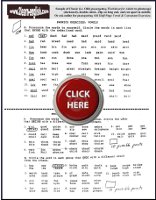 Pronunciation & Spelling = Very Old-Fashioned Short Quizzes. In the “olden days,” we used to be able to “assess mastery” of fundamental word-level language patterns with items printed on small pieces of paper. These two “ancient” two-sided pages address Consonant + Vowel Sounds & Spellings in initial, medial, and final word positions.
Pronunciation & Spelling = Very Old-Fashioned Short Quizzes. In the “olden days,” we used to be able to “assess mastery” of fundamental word-level language patterns with items printed on small pieces of paper. These two “ancient” two-sided pages address Consonant + Vowel Sounds & Spellings in initial, medial, and final word positions.
Pronunciation Key for Dictionary Use. Learners of English, especially adults,
used to refer to printed (bilingual)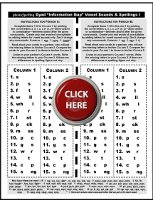 dictionaries in order to learn new vocabulary; similar information is now found online. To pronounce items correctly, it helps to know the “meanings” of the IPA sound-symbols that appear in most entries. The attached three pages, excerpted from What’s the Word? Using New Vocabulary in the Real World [ISBN 978-1-891077-01-2] offer instruction and exercises in use of a typical Dictionary Pronunciation Key.
dictionaries in order to learn new vocabulary; similar information is now found online. To pronounce items correctly, it helps to know the “meanings” of the IPA sound-symbols that appear in most entries. The attached three pages, excerpted from What’s the Word? Using New Vocabulary in the Real World [ISBN 978-1-891077-01-2] offer instruction and exercises in use of a typical Dictionary Pronunciation Key.
Writing, Practical = Chain Writing with Visuals. Two everyday forms of writing are
step-by-step instructions and image description. You can make practical writing instruction even more effective and enjoyable by basing it on visuals and incorporating natural, realistic feedback. These pages are Idea P in the newly revised classic resource Doing Without the Photocopier [ISBN 978-0-9627878-4-3].
Writing, Rhetorical Forms = Design Descriptions (World Flags).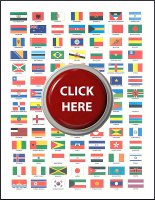 The familiar or learnable designs of 196 flags of the world provide attractive content for focus on grammar + phrasing (the simple present, there is/are, place prepositions, etc.) combined with communicative oral and/or writing + reading practice. First, print out or project the first two pages of this six-page handout in color. Without naming its country, participants in turn describe a design for listeners/readers to find. Alternatively or in addition, they can follow or adapt the instructions on the next four pages, using the provided 35 sample paragraphs as models for accurate speech or descriptive writing.
The familiar or learnable designs of 196 flags of the world provide attractive content for focus on grammar + phrasing (the simple present, there is/are, place prepositions, etc.) combined with communicative oral and/or writing + reading practice. First, print out or project the first two pages of this six-page handout in color. Without naming its country, participants in turn describe a design for listeners/readers to find. Alternatively or in addition, they can follow or adapt the instructions on the next four pages, using the provided 35 sample paragraphs as models for accurate speech or descriptive writing.
engaging and
 motivating generic activities to use for instruction in basic literacy are: [1] performing an oral chain, [2] playing Bingo or Lotto, [3] pairing up for Grid Games, [4] playing cards, and [5] doing puzzles. These five excerpts from Alphabet Answers: Everything to Know (Now . . .) About Teaching & Learning Alphabets [ISBN 978-1-934637-01-2] will tell you how to create, set up, and/or conduct such activities. Later on, their principles can be applied to a large variety of “more advanced” language-learning topics.
motivating generic activities to use for instruction in basic literacy are: [1] performing an oral chain, [2] playing Bingo or Lotto, [3] pairing up for Grid Games, [4] playing cards, and [5] doing puzzles. These five excerpts from Alphabet Answers: Everything to Know (Now . . .) About Teaching & Learning Alphabets [ISBN 978-1-934637-01-2] will tell you how to create, set up, and/or conduct such activities. Later on, their principles can be applied to a large variety of “more advanced” language-learning topics.Alphabet-Letter Activity Puzzles. Even pre–or semi-literate English language

learners are likely to learn more eagerly with appropriately leveled activities that engage and challenge. After a pedagogical Intro and before a corresponding Answer Key,these four excerpts from PhonicSpelling Puzzles, Basic Level [ISBN 978-1-934637-42-5] will serve as examples of what can be accomplished
from the very start.

Alphabet Practice = Paired-Grid Games. Follow these instructions to make Paired-Grid pages of your own to (help your English-language learners) practice and imbed the letters of the Roman alphabet. These immediately useable pages are excerpted from Alphabet-Letter Paired-Grids Tear-Off Pad, English-Roman [ISBN 978-1-934637-32-6].

All-Skills Language Instruction = Busy Pictures. One cluttered (activity) scene with many things (going on) in it can be used for a variety of language lessons that appeal to just about all learning styles. Get step-by-step instructions for four very different kinds of activities with a 2-page printable full-color sample.
Content Teaching & Learning = Quiz-Board Knowledge. Other than “lecture,” text

reading, and testing, there are many effective ways to present and practice the content of useful subjects of study. One of the simplest to prepare is a question-and-answer competition played on a familiar, classic game board. Idea X from the newly revised classic resource Doing Without the Photocopier [ISBN 978-0-9627878-4-3] will tell you what you need to know.

Grammar Lesson = Statements with BE. Get a full, 7-page lesson on the subject of Statements with BE that serves as a template for the best steps to follow in grammar presentation, practice, and use in context. These pages 5 to 10 are excerpted from Scenario Book One-A [ISBN 978-1-934637-35-7] Chapter 1.
 Grammar Lesson = A/AN vs. THE: This classic, everyday “disaster tale” introduces the articles a/an vs. the in context. Print itout, read it aloud, make use of its exercises and activities, and use it for instruction in personal story writing. These pages 177 to 183 are excerpted from Chapter 14 (Indefinite & Definite Nouns) of Scenario Book One-B [ISBN 978-1-891077-93-7].
Grammar Lesson = A/AN vs. THE: This classic, everyday “disaster tale” introduces the articles a/an vs. the in context. Print itout, read it aloud, make use of its exercises and activities, and use it for instruction in personal story writing. These pages 177 to 183 are excerpted from Chapter 14 (Indefinite & Definite Nouns) of Scenario Book One-B [ISBN 978-1-891077-93-7]. PhonicSpelling = Dyad Vowels & Consonants. An engaging, enjoyable way to
practice spellings for the 16
 or more vowel and 24 or so consonant sounds of American English is with paired info-gap activities: these promote accurate hearing, pronunciation, and spelling of useful phonics patterns in stressed syllables. Downloading these efficiently designed pages will supply five immediately useable multi-level information-gap activities, instructions, and suggested vocabulary items. They’ll also serve as models for the creation of dyad templates targeting vocabulary of your own choosing.
or more vowel and 24 or so consonant sounds of American English is with paired info-gap activities: these promote accurate hearing, pronunciation, and spelling of useful phonics patterns in stressed syllables. Downloading these efficiently designed pages will supply five immediately useable multi-level information-gap activities, instructions, and suggested vocabulary items. They’ll also serve as models for the creation of dyad templates targeting vocabulary of your own choosing.
PhonicSpelling Outline = Symbols, Sounds, Word Parts + Groups: Often requested have been clear, concise but complete compilations of language-education sub-topics. The major sections of this three-page summary of info on phonics and spelling are: [I] Characters & Symbols of the American English Phonics System, [II] 40 or More Sounds of the American English Language, [III] Word Parts, and [IV] Word Pairs or Groups.
PhonicSpelling Vowel Word-Collection Grids: Many kinds of materials—especially
visuals of the kinds offered in the
 download of All-Skills Language Instruction = Busy Pictures above—lend themselves to the collection of vocabulary items categorized by their phonetic patterns. These two immediately useable, reproducible charts focus on the spellings of simple (“short,” lax) vs. complex (“long,” tense) vowel sounds.
download of All-Skills Language Instruction = Busy Pictures above—lend themselves to the collection of vocabulary items categorized by their phonetic patterns. These two immediately useable, reproducible charts focus on the spellings of simple (“short,” lax) vs. complex (“long,” tense) vowel sounds.Pronunciation & Spelling = Very Old-Fashioned Summary. Do you ever wish you
could locate and use that
 very old, almost “primitive” handout that helped start you out on your language education career? Click here to download a nine-page Summary of Correlations between the 40 or so sounds of American English and their many, many spellings. An Answer Key follows.
very old, almost “primitive” handout that helped start you out on your language education career? Click here to download a nine-page Summary of Correlations between the 40 or so sounds of American English and their many, many spellings. An Answer Key follows.  Pronunciation & Spelling = Very Old-Fashioned Short Quizzes. In the “olden days,” we used to be able to “assess mastery” of fundamental word-level language patterns with items printed on small pieces of paper. These two “ancient” two-sided pages address Consonant + Vowel Sounds & Spellings in initial, medial, and final word positions.
Pronunciation & Spelling = Very Old-Fashioned Short Quizzes. In the “olden days,” we used to be able to “assess mastery” of fundamental word-level language patterns with items printed on small pieces of paper. These two “ancient” two-sided pages address Consonant + Vowel Sounds & Spellings in initial, medial, and final word positions. Pronunciation Key for Dictionary Use. Learners of English, especially adults,
used to refer to printed (bilingual)
 dictionaries in order to learn new vocabulary; similar information is now found online. To pronounce items correctly, it helps to know the “meanings” of the IPA sound-symbols that appear in most entries. The attached three pages, excerpted from What’s the Word? Using New Vocabulary in the Real World [ISBN 978-1-891077-01-2] offer instruction and exercises in use of a typical Dictionary Pronunciation Key.
dictionaries in order to learn new vocabulary; similar information is now found online. To pronounce items correctly, it helps to know the “meanings” of the IPA sound-symbols that appear in most entries. The attached three pages, excerpted from What’s the Word? Using New Vocabulary in the Real World [ISBN 978-1-891077-01-2] offer instruction and exercises in use of a typical Dictionary Pronunciation Key.Writing, Practical = Chain Writing with Visuals. Two everyday forms of writing are

step-by-step instructions and image description. You can make practical writing instruction even more effective and enjoyable by basing it on visuals and incorporating natural, realistic feedback. These pages are Idea P in the newly revised classic resource Doing Without the Photocopier [ISBN 978-0-9627878-4-3].
Writing, Rhetorical Forms = Design Descriptions (World Flags).

For a list of titles offered for sale, you can click here: Alphabetized Authors & Editors Product List. More information about products is available in the print or Online Authors & Editors Creative Language Teaching & Learning Catalog and at the Authors & Editors Online Store. No-cost materials can be downloaded from Teaching Tools, Tips, & Techniques--as can the Try-Before-You-Buy samples attached to product descriptions.



